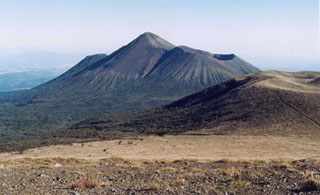Report on Kirishimayama (Japan) — 28 March-3 April 2018
Smithsonian Institution / US Geological Survey
Weekly Volcanic Activity Report, 28 March-3 April 2018
Managing Editor: Sally Sennert.
Please cite this report as:
Global Volcanism Program, 2018. Report on Kirishimayama (Japan) (Sennert, S, ed.). Weekly Volcanic Activity Report, 28 March-3 April 2018. Smithsonian Institution and US Geological Survey.
Kirishimayama
Japan
31.934°N, 130.862°E; summit elev. 1700 m
All times are local (unless otherwise noted)
Based on observations during overflights on 28 March and 2 April, JMA reported that the crack on the W flank of Shinmoedake (Shinmoe peak), a stratovolcano of the Kirishimayama volcano group, continued to widen. White emissions rose as high as 500 m above the crater rim. Several high-temperature regions around the margins of the lava in the crater, and from the flow on the NW flank, were detected on 28 March. The lava flow on the NW flank advanced 85 m from 9-29 March. Sulfur dioxide emissions were 300 tons/day on 30 March. The number of volcanic earthquakes began to decline after 26 March; though from 0014 to 1430 on 3 April the number increased to 239. Many low-frequency earthquakes with shallow hypocenters continued to be recorded. The Alert Level remained at 3 (on a scale of 1-5).
Geological Summary. Kirishimayama is a large group of more than 20 Quaternary volcanoes located north of Kagoshima Bay. The late-Pleistocene to Holocene dominantly andesitic group consists of stratovolcanoes, pyroclastic cones, maars, and underlying shield volcanoes located over an area of 20 x 30 km. The larger stratovolcanoes are scattered throughout the field, with the centrally located Karakunidake being the highest. Onamiike and Miike, the two largest maars, are located SW of Karakunidake and at its far eastern end, respectively. Holocene eruptions have been concentrated along an E-W line of vents from Miike to Ohachi, and at Shinmoedake to the NE. Frequent small-to-moderate explosive eruptions have been recorded since the 8th century.

